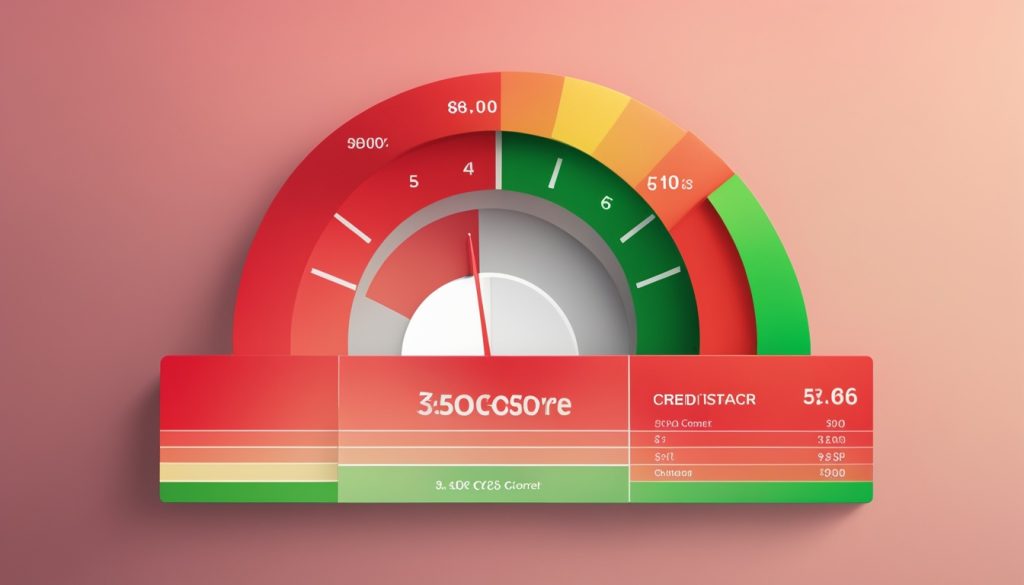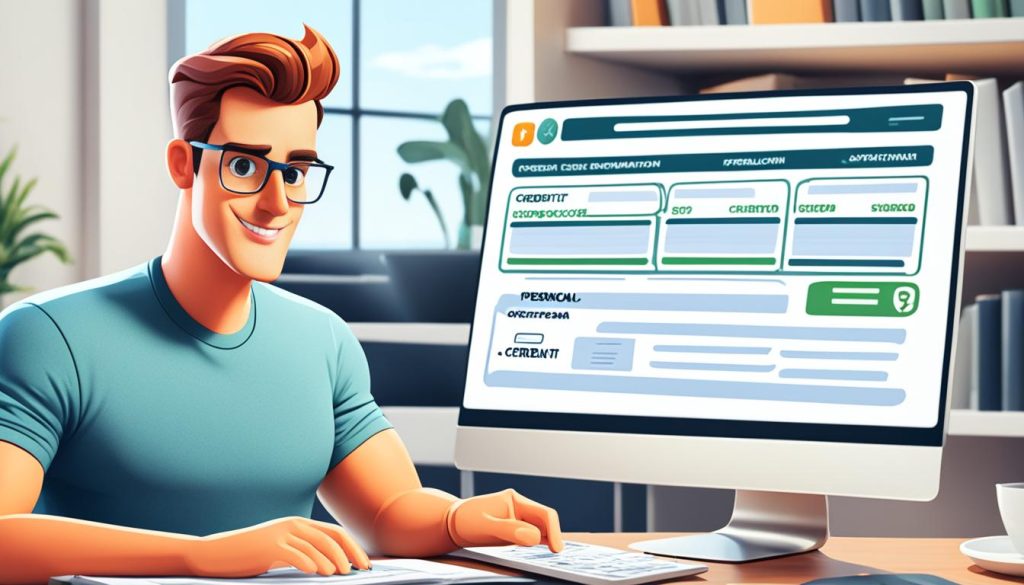Applying for a personal loan is easy and can help you cover various expenses. This includes unexpected bills, debt consolidation, or big purchases. Knowing the steps can boost your chances of getting the right loan for your needs and budget1.
The process starts with figuring out how much you need to borrow. Then, you review your finances and look at different lenders. After that, you get pre-qualified and submit an application. Loans can be as small as $250 or as big as $100,0001. This way, you can borrow just what you need without taking on too much debt1.
Applying for a personal loan usually takes just a few minutes. You could get the money the next business day or even faster1. But, the time it takes to get approved can change. This depends on your credit score, income, debt, and what the lender wants2.
Key Takeaways
- Personal loan amounts can range from $250 to $100,000, with borrowing between $250 and $100,000 being common to avoid overborrowing.
- Personal loan applications can generally be completed in a few minutes, with funding potentially arriving the next business day or sooner.
- Credit scores play a significant role in loan eligibility and interest rates, with excellent credit (800+) typically qualifying for the best rates.
- Lenders evaluate factors such as credit history, income, debt-to-income ratio, and work history to assess borrower risk and determine loan approval.
- Comparing personal loan options from multiple lenders can help you find the best terms and rates to meet your financial needs.
Understanding the Personal Loan Process
A personal loan can help with many financial needs. It’s great for consolidating debt, handling unexpected costs, or buying something big. These loans come with fixed interest rates and repayment plans, making budgeting easier3.
What is a Personal Loan?
A personal loan doesn’t need collateral like a house or car. It has fixed interest rates and repayment times, making budgeting simple3. You get the money all at once and pay it back over a set period, usually one to ten years3.
When to Consider a Personal Loan
Personal loans are useful in many situations. They’re good for paying off high-interest debt, like credit card bills, making payments easier and saving on interest3. They also help with big expenses or purchases that are hard to fit into your budget3.
Personal loans often have fixed terms and lower interest rates than other options, like credit cards or home equity loans3. Knowing how personal loans work and their benefits can help you decide if they’re right for you.
| Lender | APR Range | Loan Amount | NerdWallet Rating |
|---|---|---|---|
| Partner 1 | 8.99% – 29.99% | $5,000 – $100,000 | 4.5 |
| Partner 2 | 9.95% – 35.99% | $2,000 – $35,000 | 4.0 |
| Best Egg | 8.99% – 35.99% | $2,000 – $50,000 | 4.5 |
| LightStream | 6.99% – 25.49% | $5,000 – $100,000 | 5.0 |
The table shows APR ranges, loan amounts, and NerdWallet ratings for different lenders4. This info helps you compare and find the best fit for your needs and credit.
“Personal loans can be a valuable tool for managing your finances, whether you’re looking to consolidate debt, cover unexpected expenses, or make a significant purchase.”
Your credit score and other factors affect the interest rate and loan terms you get. If your credit score is 800 or higher, you can get the best rates3. Understanding personal loans and your finances helps you decide if one is right for you34.
Evaluate Your Credit and Financial Situation
Before you apply for a personal loan, make sure to check your credit and finances. Start by looking at your credit score, which goes from 300 to 8505. This score tells lenders if you’re good for a loan and what terms they can offer you. Also, check your credit report for mistakes or things you can fix, like paying off credit cards.
Check Your Credit Score and Credit Report
Your payment history is key to your credit score, making up 35% of FICO and 41% of VantageScore5. How much credit you use is also important, making up 30% of FICO and 20% of VantageScore5. Knowing these parts helps you improve your score and look better to lenders.
Calculate Your Loan Affordability
After checking your credit, figure out how much you can borrow. Think about your income and expenses to see what you can afford each month. Lenders look at your credit history, cash flow, collateral, and character when deciding on your loan6. By understanding your finances, you can pick a loan that fits your budget and repayment ability.

| Credit Scoring Factors | FICO | VantageScore |
|---|---|---|
| Payment History | 35% | 41% |
| Credit Utilization | 30% | 20% |
| Credit History | 15% | 20% |
| New Credit | 10% | 11% |
| Amounts Owed | 30% | 20% |
“By taking the time to assess your financial situation, you can ensure that you apply for a personal loan that aligns with your budget and repayment capabilities.”
Looking at your credit score, credit report, and loan affordability is key before applying for a loan. This helps you know your creditworthiness, what to work on, and what loan amount and terms you can handle. With this info, you can find the best loan for your needs56.
Research and Compare Lenders
Looking for a personal loan means you should check out different lenders. You’ll find options from online lenders, banks, and credit unions. Each has its own benefits and things to consider. Online lenders might offer more loan amounts and easier credit score checks. Banks and credit unions can give you a more personal service and possibly lower rates if you qualify7.
Consider Lender Options
Begin by looking at what online lenders, banks, and credit unions offer. Sites like SoFi, Happy Money, and Upgrade make applying easy and can get you money the next business day8. Banks and credit unions might give you lower rates if you have great credit9.
When you’re comparing, focus on the interest rates, fees, and how you’ll repay the loan. Personal loan APRs can be from 7.99% to 35.99%, with the best rates for those with top credit scores7. You might also see fees from 0.00% to 9.99% of the loan7. Loans can last from 12 to 84 months, so pick a term that works for you7.
| Lender | Estimated APR Range | Loan Terms | Loan Amounts |
|---|---|---|---|
| SoFi | 8.99% – 29.99% | 24 – 84 months | $5,000 – $100,000 |
| Happy Money | 11.72% – 17.99% | 24 – 84 months | $5,000 – $40,000 |
| Upgrade | 8.49% – 35.99% | 24 – 84 months | $1,000 – $50,000 |
By looking at your options and picking the right loan, you can get the money you need without paying too much8.
personal loan application, loan approval, borrowing money
Applying for a personal loan means filling out a form with your chosen lender. You’ll need to share personal and financial info like your name, where you live, your job details, and how much you earn10. The lender will check your application and credit to see if you can get a loan and what the terms will be.
If you get approved, you’ll look over and agree to the loan documents. These will show the loan amount, interest rate, how long you’ll pay it back, and your monthly payments. After agreeing, the lender will send you the money, usually in a few business days, either by direct deposit or check10. For those outside the U.S., you can borrow up to $25,000, while U.S. Bank customers can borrow $1,000 to $50,00010.
The loan approval depends on your credit and meeting certain rules10. Personal loan APRs can be between X.XX% and 24.99%, with the best rate at 8.74%10. You can choose a loan term from 12 to 84 months, up to 60 months for non-U.S. Bank customers10.
U.S. Bank personal loans don’t need collateral and don’t have fees or penalties for paying off early10. For instance, a $10,000 loan over 36 months at 8.74% APR would cost $316.79 a month10. Getting the money to a non-U.S. Bank account might take one to four business days10.
Other lenders, like SoFi, also offer personal loans with great features. SoFi has helped members pay off over $26 billion in debt with their loans11. SoFi’s average APR for a 5-year loan is 14.83%, and you can borrow $5,000 to $100,00011. SoFi loans don’t have fees for origination, prepayment, or being late11.
LightStream Personal Loans have APR from 6.99% to 25.99% with AutoPay12, and Happy Money offers loans from 11.72% to 17.99% for paying off debt12. You can borrow $2,000 to $100,000 with these lenders, over 24 to 240 months12.

When you’re looking for a personal loan, it’s key to compare different lenders to find the best deal for you. Knowing how to apply for a loan, get approved, and get the money helps you make a smart choice. This way, you can take advantage of the many financing options out there101112.
Submit Your Application and Required Documents
When you’re ready to apply for a personal loan, start by gathering the needed documents and info13. You’ll likely need a government ID like a Social Security Number (SSN) and driver’s license number. Also, proof of where you live and how much you earn through pay stubs or tax returns1314.
Many lenders make applying online easy, letting you send your info fast13. But, some might want you to apply in person. It’s key to give accurate and full info to make the approval process smoother13.
After you send in your loan application and documents, the lender will check your info and make a decision13. This could happen in minutes or a few days13. If they say yes, you might get the loan money in a couple of business days13.
Some lenders might need to deposit the loan money directly into your bank account and take automatic payments13. Also, different lenders offer loans with various interest rates and terms based on your credit score and income1314.
Knowing how to apply for a personal loan and what documents you need helps you start getting the financing you need1314. Always look at offers from several lenders to make sure you’re getting the best deal for your loan13.
| Required Documents for Personal Loan Application |
|---|
| Social Security Number (SSN) |
| Government-issued ID (e.g., driver’s license) |
| Proof of Residence (e.g., utility bill, lease agreement) |
| Income Verification (e.g., pay stubs, tax returns) |
| Bank Statements (for income and financial assessment) |
By collecting these documents and filling out your loan application fully, you boost your chances of getting approved and getting the loan you need1314.
Conclusion
Applying for a personal loan is easy if you know the steps. Start by checking your credit and financial situation. Then, look for the best lenders and fill out your application fully with all needed documents15.
Always borrow money wisely, making sure you can afford the monthly payments. A good personal loan can help you pay for big expenses, combine debts, or buy something big. This can help you reach your financial planning goals16.
The steps to apply for a loan and get approved can change with each lender. But knowing the usual steps, like the16 Five C’s of Credit, can make it easier. By being well-informed and making smart choices, you can get the money you need for your financial goals.
FAQ
What is a personal loan?
A personal loan is a type of loan without collateral. It’s used for things like paying off debt, covering unexpected costs, or buying big items. These loans have fixed interest rates and repayment plans, making it easier to manage monthly payments.
When should I consider a personal loan?
Think about a personal loan if you need money but don’t want to use credit cards or home equity. Personal loans often have fixed terms and lower interest rates. This makes them a cheaper option compared to other ways to borrow money.
How do I evaluate my credit and financial situation?
Before applying for a personal loan, check your credit score to see how lenders will view you. Look over your credit report for mistakes or areas to improve, like paying down credit card debt. Also, figure out how much you can afford to borrow by considering your income and expenses.
How do I research and compare personal loan lenders?
After checking your finances, look into different personal loan lenders. Look at online lenders, banks, and credit unions and compare their rates, fees, and terms. Online lenders might offer more loan options and flexible credit requirements. Banks and credit unions might give you better rates if you qualify and offer more personal service.
What does the personal loan application process involve?
Applying for a personal loan means filling out a formal application with a lender. You’ll need to provide personal and financial details like your name, address, job info, and income. The lender will check your application and credit to see if you qualify and at what terms. If you get approved, you’ll review and sign the loan documents. These will show the loan amount, interest rate, repayment time, and monthly payments.
What documents do I need to apply for a personal loan?
When applying for a personal loan, collect the documents the lender asks for. This could be a government ID, proof of where you live, proof of income like pay stubs or bank statements, and tax returns. Many lenders let you apply online, which is fast and easy. But some might want you to apply in person.
Source Links
- How To Apply for a Personal Loan in 5 Steps in 2024
- How To Get A Personal Loan: 9 Steps & Expert Tips | Bankrate
- How Do Personal Loans Work?
- How to Get a Personal Loan in 7 Steps – NerdWallet
- How Your Credit Score Affects A Loan Application | Bankrate
- What Banks Look for When Reviewing a Loan Application
- How to Compare Personal Loans From Different Lenders
- Best Personal Loans of 2024
- Does Your Loan Purpose Matter? Yes — Here’s Why | Bankrate
- Personal loans at U.S. Bank
- Personal Loans – Apply Online, Same Day Funding | SoFi
- 5 lenders that let you apply for a personal loan completely online
- How to Fill Out a Personal Loan Application
- What Documents Are Required For A Personal Loan? | Bankrate
- 5 Personal Loan Requirements To Know Before Applying
- The 5 basic steps of the loan approval process

